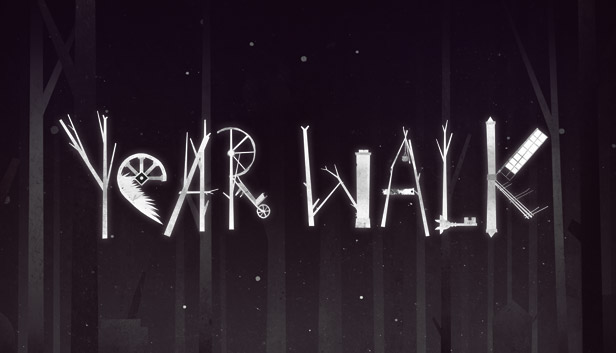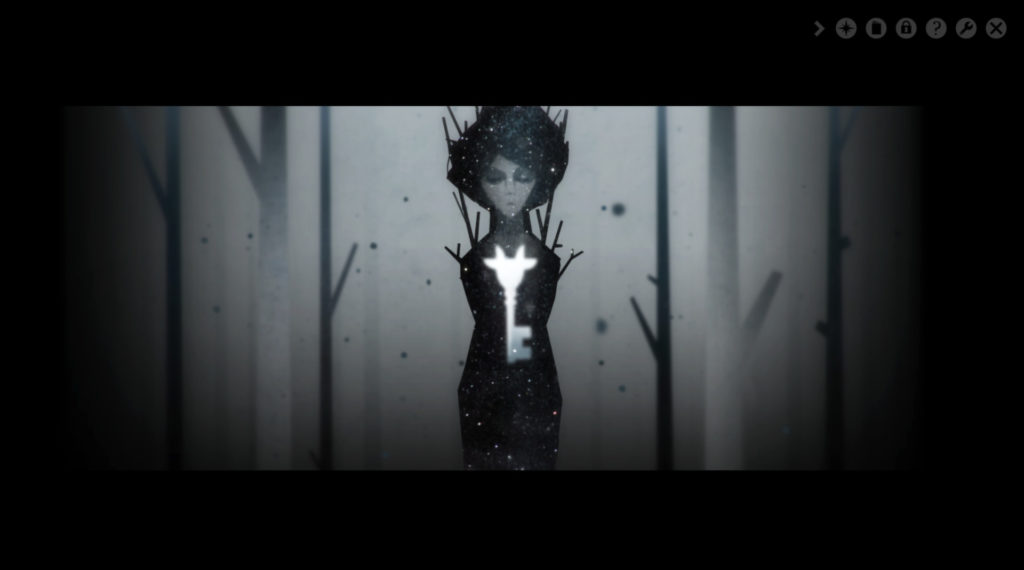For this week’s critical play, I played Year Walk, a horror-mystery-puzzle game developed by Simogo. Although this game was initially released for iOS and mobile, I played the Steam version, which was described as being an even more enhanced and immersive experience. By nature of it being somewhat of a suspense/horror game, the game seems intended for a teen/young adult and up audience.
 In Year Walk, you control a nameless protagonist on a vision quest in the snowy forest of 19th century Sweden. The game gives you very little initial information to go off of – all you know is that you live in a cabin out in the wilderness, and you have a loved one who lives in a windmill nearby. But why does she worry about anyone seeing you come to visit her? Who is “coming to take her back” tomorrow? What is this “year walk” that your character discusses with her? When she disappears the next day, you are left to figure these out for yourself. As you traverse throughout the forest, you come across progressively more strange, surreal, and downright disturbing sights that define the game’s narrative and discovery-focused fun. For example, one puzzle involves following a ghostly woman who looks almost like your loved one, and using the eerie pitch of her voice to choose the correct path. This puzzle not only mechanically immersed me, but narratively immersed me – was this what she meant when she said she would be “taken back”?
In Year Walk, you control a nameless protagonist on a vision quest in the snowy forest of 19th century Sweden. The game gives you very little initial information to go off of – all you know is that you live in a cabin out in the wilderness, and you have a loved one who lives in a windmill nearby. But why does she worry about anyone seeing you come to visit her? Who is “coming to take her back” tomorrow? What is this “year walk” that your character discusses with her? When she disappears the next day, you are left to figure these out for yourself. As you traverse throughout the forest, you come across progressively more strange, surreal, and downright disturbing sights that define the game’s narrative and discovery-focused fun. For example, one puzzle involves following a ghostly woman who looks almost like your loved one, and using the eerie pitch of her voice to choose the correct path. This puzzle not only mechanically immersed me, but narratively immersed me – was this what she meant when she said she would be “taken back”?
The mechanics are quite simple: you can walk left, right, forward, and back between various 2D screens, and can left click and drag on certain objects in the environment. However, I was pleasantly surprised that these mechanics were more than enough to support the mystery of the game. I witnessed a good variety of puzzles that created a challenging sort of fun – logic, audio, visual, even ones that used the in-game encyclopedia or my own keyboard as a one-off mechanic. One of my favorites involved a creepy 3D spinning doll (which stood out in contrast to the rest of the mostly 2D game), whose erratic arm movements actually spelled out the combination to a door in another area of the map.
Finally, I would be remiss if I did not mention the most immersive element part of Year Walk: the horror elements. The phenomenal art/sound design gave me an actual feeling of dread when solving puzzles (which was not unfounded, as the game did not shy away from dealing out scares). Even just the general setting of the game of being out in a supernatural wintery forest made me feel like anything could happen at any moment. The horror elements created a sensation-type of fun, which I believe was actually the strongest type of fun from the game.
Overall, I had a great time playing Year Walk, and would recommend it to anyone looking for a mysterious narrative splashed in with a healthy dose of spooks.


